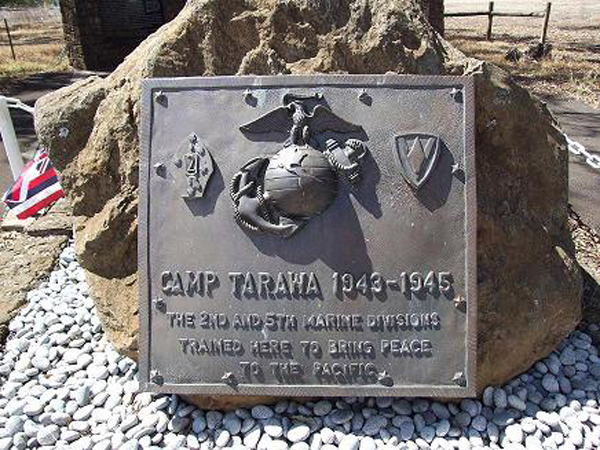Camp Tarawa Today
Kamuela (Waimea) is located at the intersection of the Mamalahoa Highway (Highway 190) and Kawaihae Road (Highway 19) in the northwest part of the island of Hawai’i. In 1943, it was a small town of about 400 called Kamuela and its residents were almost totally dependent on the Parker Ranch for their livelihood.
Camp Tarawa was located on Parker Ranch property in and around Kamuela from 1943-1945. The camp was between the volcanic peaks of Mauna Kea and Mauna Loa. The Marines and Seabees were at four locations: the camp main side at Kamuela; the artillery camp at Pohakuloa; the amtrac camp at Hapuna Beach and the division rear at the port facilities in Hilo. Most unit headquarters, tent camps, mess halls, clubs, recreation facilities, warehouses, etc. were located at main side. There were large outlying training areas surrounding the camps for small arms practice, an artillery range, amphibious training and other purposes.

Main Side, Camp Tarawa, 1944-45
The 2nd Marine Division was sent to Camp Tarawa in December, 1943 after the World War II battle of Tarawa to recuperate, get replacements and train for the Saipan and Tinian campaigns in the Pacific. The 2nd Marine Division named their camp after the brutal battle they had just fought to honor the Marines who died there. The division departed from Camp Tarawa in the spring, 1944.
The 5th Marine Division used Camp Tarawa beginning in the fall, 1944 to train for the assault on Iwo Jima. The 5th Marine Division left the camp in late December, 1944 and returned to the camp in March 1945 after the battle of Iwo Jima to recover, get replacements and prepare for the invasion of the Japanese mainland.
The Japanese surrendered in August 1945, ending the war. The Fifth Division left late that month for occupation duty in Japan. The camp was closed in November 1945. The Parker Ranch leased the property for the camp to the U.S. Government for $1 with the requirement that the property be returned to its prior condition at the end of the lease. For that reason, there are very few buildings left from the camp. The Marines, Navy corpsmen and Seabees lived in tents but some Quonset huts and other buildings were erected and some local existing buildings were used for the camp.
Camp Memorial: The memorial shown below is located on west side of Mamalahoa Highway south of town and just north of the entrance into the Parker Ranch headquarters. Ranch owner Richard Smart donated the land for the Camp Tarawa memorial. The large rock with the brass plaque was erected in 1984 and the granite panels part of the memorial behind the rock were dedicated in 1998. The west bound road behind the gate that can be seen from the memorial was the main entrance into the camp. Vast tent camps were along both sides of this road.

July 2016
Parker Ranch Historic Home/Pu’u’opelu: Ranch owner Richard Smart offered his home Pu’u’opelu, shown in the photos below, as headquarters for the Marines. The building is now the Parker Ranch headquarters which contains historical exhibits. The road (Pu’u’opelu Road) west to the museum from the Mamalahoa Highway is just south of the Camp Tarawa memorial. The camp parade ground was near the headquarters building. Just north of the headquarters building is an old road that topographical maps show going to the base of Buster Brown Hill. This was likely the route the Marines used for their training hikes.
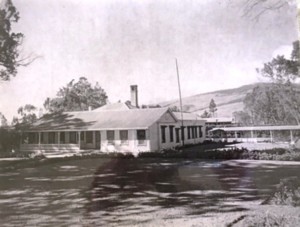
1943-45
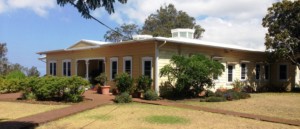
July 2016
Barbara (Kahilu) Hall/now Parker School: This was an existing building, since remodeled, which served as the main USO for Camp Tarawa. The building is located on the north side of Lindsey Road across from the county park. It was the site of dances to music played by famous orchestras, entertainment by big-name stars and other recreational activities. There is a memorial in front of the building. The camp also had outdoor stages and movie screens for showing films.

1943-45

February 2017
Site of Hospital: The Waimea Elementary School and Waimea Hotel were used for a hospital and nurses’ quarters. The hospital was located on the west side of the Mamalahoa Highway across from the present day Waimea Elementary School. The hotel was just north of the school on Lindsey Road. The former school building and nurses’ quarters were later moved west along Kawaihae Road to near where the Longs Drugstore is presently located. The former school building is on the north side and is used as the Isaacs Art Center and the former nurses’ quarters on the south side is used as the Gallery of Great Things. The site of the former school is currently a large vacant lot.
Waimea County Park: This is the site of the camp recreation field. The baseball field was called Iwo Jima Field after the 5th Marine Division returned to the camp following the battle. The park is located south across the street from Parker School on Lindsey Road and north of Kawaihae Road as you near the center of town. The park was a busy place as sports were a big part of the camp activities for the Marines both as participants and spectators. There were division and regimental level baseball teams and unit softball teams that competed as well as boxing matches, basketball games and tug-of-wars. The division band also practiced on this field.
Buster Brown Hill: Marines of the 5th Marine Division climbed this imposing hill just north of town, and other hills, in preparation for the climb up Mount Suribachi on Iwo Jima. The photo of Buster Brown Hill was taken from near the main gate into the camp.

Iwo Jima, February 1945
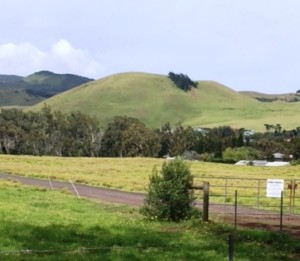
Buster Brown Hill, February 2017
Flag Pole/ School Building: Since the Marines were using the town school building as a hospital, private homes and even a garage were used as schools for the local children until the engineers of the 2nd Marine Division built a new school south across from the county park near the St. James Episcopal Church. The building still stands along St. James Circle Drive, as shown below, and is currently being used by the Waimea Country School, a private school. The original flagpole at the entrance to Camp Tarawa was saved and moved to the front of this building.
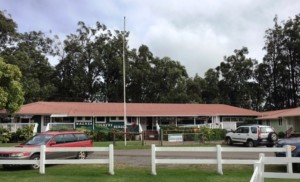
February 2017
Bordelon Field: This was the camp aircraft landing strip on the west side of Mamalahoa Highway just south of Lalamilo Farm Road at the south side of town. The outline of the abandoned landing strip can be seen on old topographical maps and Google Earth. Bordelon Field was named after Marine William Bordelon who was killed in action at Tarawa. He was posthumously awarded the Medal of Honor for his bravery. The present Waimea-Kohala airport is south of this site on the east side of the highway.
Quonset Huts: In July 2011, two quonset huts remained that were used by the Marines on the west side of Mamalahoa Highway south of town. By July 2014, only one remained as shown on the left below which was just north of the Camp Tarawa memorial. This quonset hut was used as a “slop chute” (beer hall) by the 28th Marines. It was still there in May 2015 but gone in July 2016. Only the cement foundation remains. There is still a former Marine quonset hut being used as part of the Waimea Express gas station at the west edge of town on the south side of Kawaihae Road at its intersection with Opelo Road. It is in the photo to the right below.
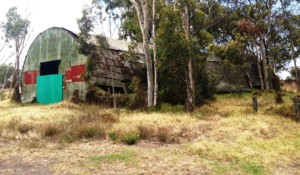
May 2015

July 2014
Hapuna Beach/Camp Drewes: Hapuna Beach is one of the most popular beaches on the island today but it was once the site of amphibious training for the Marines’ Pacific Island campaigns. Camp Henry Drewes, the camp of the 2nd Amtrac Battalion was at the beach and where the Hapuna Prince Hotel is now located. The camp was named for Major Drewes, the commanding officer of the 2nd Amtrac Battalion, who died on November 20, 1943 of wounds received in the battle of Tarawa. There is a marker for the camp at the west end of the beach parking lot which is shown below.
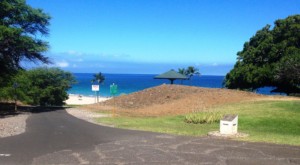
July 2016
Church Road: The churches along historical Church Road on the west side of the Mamalahoa Highway north of Waimea were there during the Camp Tarawa period. Marines were welcomed to the local churches.
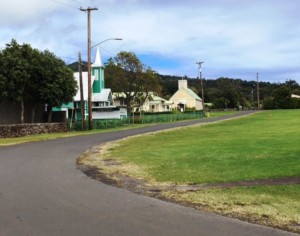
Church Road, February 2017
Rodeo Grounds: The arena where the Marines participated in rodeos with the local paniolos (cowboys) is still being used just south of town on the east side of the Mamalahoa Highway at Ala Ohia road. The current grandstand does not date from the camp period but the oval arena itself is in the same location.
Pohakuloa Artillery Camp: This camp was along Saddle Road (present day Daniel K. Inouye Highway) at what is now the U.S. Army Garrison-Pohakuloa Training Area (PTA) used by both the Army and Marines. There are many old looking quonset huts visible from the highway but none of them were there in the 1943-45 period.
Hilo: The Pioneer Battalion was the division rear at Hilo for both the 2nd and 5th Divisions. Hilo had the only port facilities on the island that could handle the transports that brought the Marines to the island and took them to the next battle. The Marines were transported to and from the docks by train and trucks. A cadre of Marines and Seabees remained at Hilo as security for the port and Naval Air Station (present day Hilo airport), to handle the supply ships for the camp and to keep the port facilities ready for embarkation. Camp Banyan was on the south west side of Banyan Drive across from Reeds Bay on the site of the present golf coast. The Mokuola USO was on Coconut Island northwest of Banyan Drive. The old Naniloa Hotel along Banyan Drive was where USO entertainers stayed when they came to entertain the Marines on the island. The port facilities at Hilo are still in the same location as in 1943-1945. Standing on the shore at Reeds Bay, it doesn’t take much imagination to visualize Navy transport ships at the docks instead of the cruise ships that are often there today.
Other Places: There are several commercial buildings in Waimea dating from the camp period that were part of the Marines landscape. The former Bric-a-Brac shop is on the north side of Lindsey Road just west of Mamalahoa Highway and the former Choc Inn, a general store, is on the south side of Kawaihae Road just west of St James Church. Both buildings have been enlarged and remodeled. The old Parker Ranch slaughter house is at the east end of Lindsey Road. There is a former Japanese theater building, now a liquor store, on the north side of the Mamalahoa Highway at the east edge of town. Honoka’a (Honey Cow), a town northeast of Waimea along the Mamalahoa Highway, was a favorite liberty destination. The Immaculate Conception Roman Catholic Church at 76-5960 Mamalahoa Highway in Holualoa contains a plaque honoring the Marines of the 2nd Division who helped rebuild the church while at Camp Tarawa.
Semper Fi!
(Photo credits: historical photos – Camp Tarawa Detachment, Marine Corps League. All others: Fred Greguras.)
______________________________________________________________________
My special thanks to Kathleen Painton for her help on this paper. Kathy lives on the Big Island and is a member of the Camp Tarawa detachment of the Marine Corps League. She gives tours of the camp as a public service. Her father was with the 28th Marines at Camp Tarawa and was killed on the beach on Iwo Jima in World War II. She has climbed Mt Suribachi on Iwo Jima to complete her father’s mission. She can be reached at kathypainton@hotmail.com.
March 15, 2017
Fred Greguras has visited and photographed the memorial and other Camp Tarawa sites numerous times. He is an amateur historian and served as a platoon leader with H/2/5 of the 1st Marine Division in the Vietnam War. He can be reached at fgreguras@hotmail.com.


